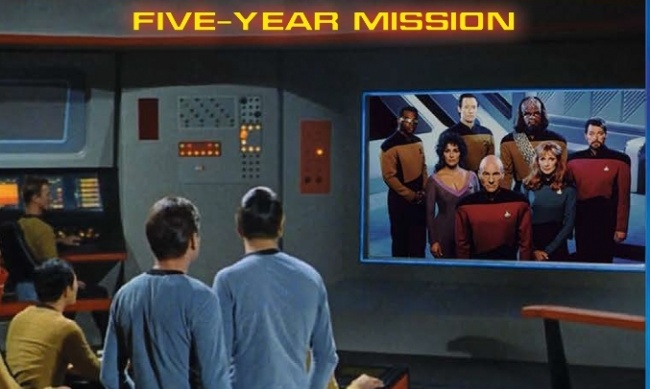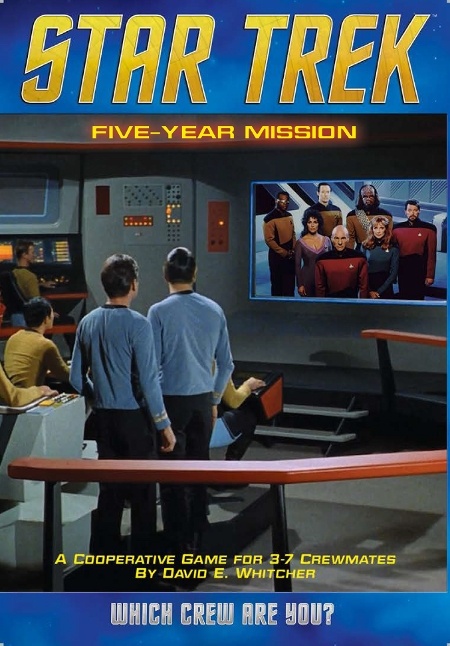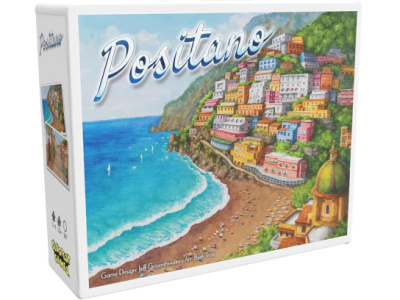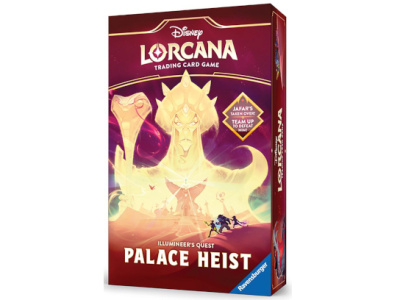Star Trek: Five-Year Mission
Publisher: Mayfair Games
Release Date: August 2015
MSRP: $35.00
Game Designer: David Whitcher
Format: Card and dice game
Players: 3-7
Age Rating: 10+
Playing Time: 30-45 minutes
Product #: MFG4139
UPC: 0-29877-04139-8
ICv2 Rating: 4.5 Stars out of 5
There is nothing individually groundbreaking in this game, but the implementation is a real treat. Because players represent the bridge crew of the Starship Enterprise, it's a co-op game. Let's face it, if the ship blows up, everyone loses…
The mechanics of the game are simple. Each player draws an "alert" card, which has symbols and text on it, spelling out the effects of the card. Players will want to "defeat" each card, either to end the effects or to gain victory points, or both. This is done by a "worker placement" mechanic, in which players roll dice from a small pool, and the colors and values determine where they can be used to take cards out of play, and put them in the discard pile or scoring pile. Some cards take immediate priority, or have a time limit, which adds pressure. There is an egg timer in the game for those timed cards.
If you reach your victory point goal before failing five alerts, the crew of the Enterprise wins. If you either fail to address five alerts, or let the ship blow up, you lose.
Because the game is designed to play as either the original series or the Next Generation crew, the "board" is two-sided, as are the player charts. For instance, Mr. Spock is on one side of a chart, and Commander Riker on the other, for the second-in-command position.
Each character has different abilities, based on the stories from the TV shows, and these come into play in interesting ways, to manipulate the dice or the "alert" cards. For instance, Captain Picard gets an extra die, representing him thinking his way out of trouble, and Captain Kirk gets to re-roll some of them, reflecting his ability to "change the rules" in a crisis. These and the other abilities work well in context, and if you have fewer than seven players, it becomes interesting to see which characters work best to keep the Enterprise flying. In play, you really tend to need the Captain, the First Officer and either the medical officer or the engineer, but the choice between keeping the crew healthy and keeping the ship flying can be a difficult one. So, it may play best with four or more players. You could have two or three players each playing two characters, as an interesting variant.
An additional promo crew chart, with Yeoman Rand on one side and Wesley Crusher on the other, was unfortunately a little jokey on the Wesley side, but otherwise the crew charts were nicely designed, and the abilities well balanced.
The graphics draw from stills from the two series, and are clean and clear. The only visual weakness in the game is that the Federation seal on some of the cards is very difficult to spot at a glance, often being a dark seal on a dark background. Since that seal indicates a card which takes immediate priority, this is a minor problem in actual play, as things get heated, such as when the timer is running on another alert.
As with many games, the suggested length will increase if you get up to the full seven players, but most of the time there is interaction between players, even when it is not their turn. One odd feature is that you can add or subtract a player in mid-game without ruining the flow, because of the mechanics and its co-op nature. Only players who dislike co-op games or Star Trek will have reason to avoid this one.
The game is suitable for adults, teens, and older children, and is well worth the price.
--Nick Smith: Librarian Technician, Community Services, for the Pasadena Public Library in California.

ICv2 Stars: 4.5 (out of 5)
Posted by Nick Smith on January 29, 2016 @ 1:34 am CT
MORE GAMES
With 'Fanzone: Electronic Football Trivia Game'
July 18, 2025
Ultra PRO will release Fanzone: Electronic Football Trivia Game into retail.
Booster Set Adds King Ghidorah, Gigan, and Spacegodzilla
July 18, 2025
Bushiroad announced a second booster set for Godzilla Card Game.
MORE REVIEWS
ICv2 Stars: 4 (out of 5)
July 11, 2025
Here's a review of Positano, published by Slugfest Games.
ICv2 Stars: 3.5 (out of 5)
June 20, 2025
Check out the review of Disney Lorcana TCG: Illumineer's Quest - Palace Heist, from Ravensburger.








